In recent days, the Egypt Exploration Society has disclosed that 11 manuscripts from their Oxyrhynchus collection were allegedly illegally sold by Professor Dirk Obbink to the Hobby Lobby organization. Two further fragments of pieces from the Oxyrhynchus collection have surfaced in a different American collection. I’ve been quoted in several news outlets as saying that we don’t yet know the scope of this problem. What I mean by this is that in the decade since Professor Obbink first connected with the Scott Carroll and the Green family’s Hobby Lobby organization, ancient manuscripts of surprising quantity and quality have appeared on the antiquities market. Many of these pieces appeared with no provenance information or with very problematic or dubious provenance stories. I began to compile this list some time ago, taking inspiration from the very useful collection of data on post-2002 “Dead Sea Scrolls” at the blog of the Lying Pen of Scribes project and a list of known Green Collection manuscripts posted to Twitter by David Bradnick. In light of recent developments, it seems like a good idea to make this list “live” now, even in an incomplete state. I’m focusing here on literary manuscripts in Greek and Latin that have shown up since about 2010. I’m starting with some classical papyri (this is not just a “Bible” thing; this mess affects you too, classicists) and early Christian pieces that did not appear on the list of items already known to have been stolen from the Egypt Exploration Society, which can be found here.
As will become clear, many of these pieces are linked to Scott Carroll, who was in charge of acquisitions for the Green Collection at the time when Professor Obbink is said to have sold the Oxyrhynchus papyri to the Greens. This connection suggests that other pieces of dubious provenance linked to Carroll may also go back to Prof. Obbink. So, I’m imagining this page as a kind of clearing house for items on the market that might be linked back to Dirk Obbink and from there back to the Oxyrhynchus collection. When I say “First appearance,” I mean the first time I know of the piece being displayed publicly. I welcome corrections. So, with full knowledge that this list will never be even close to comprehensive, here we go.
[[Update 21 October 2019: Since I posted this list three days ago, two of these pieces have now been identified as having been stolen from the Egypt Exploration Society, and four others have been identified as unpublished pieces that remain in the EES collection; see updates below and the EES announcement here.]]

Plato, Phaedo. First appearance: 2013. Reused papyrus roll. Appraised by Lee Biondi with assistance from Dirk Obbink with an inventory number of VKGrpap.38 suggesting it may have been part of the Van Kampen Collection. But representatives of the Van Kampen Collection have not responded to my requests to confirm that connection. Manuscript dated by Obbink to the second century CE. Later in the possession of Scott Carroll. More info here.
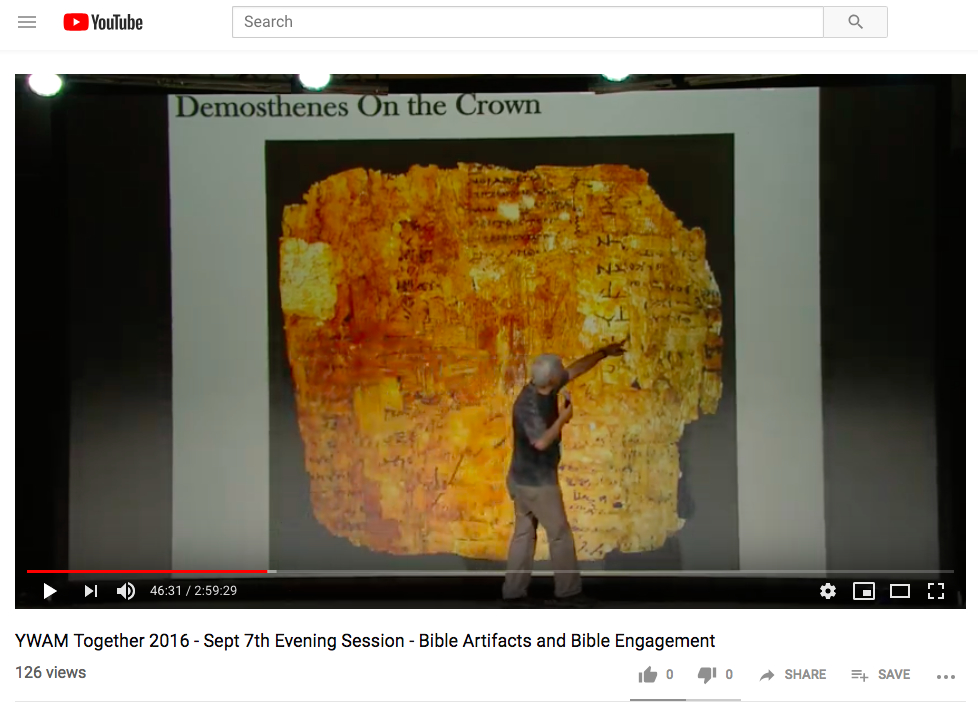
Demosthenes, On the Crown? (unconfirmed identification by Scott Carroll). First appearance: 2011? If the identification is correct, this would probably be a part of the Green Collection (GC.PAP.000353), which is said to be in the process of publication by Harvey Yunis. Image displayed by Scott Carroll in 2016. More info here.
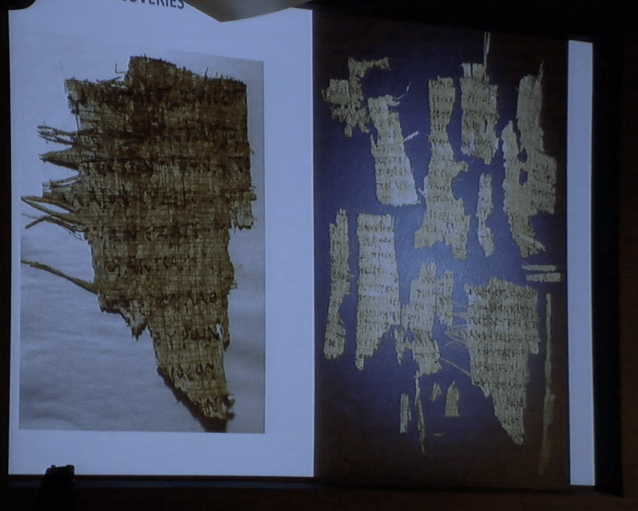
Menander? (no work named, unconfirmed identification by Scott Carroll). First appearance: 2014. Papyrus displayed by Scott Carroll in 2014. More info here.

Commentary on Dionysus and mystery rites (Green Collection). First appearance 2011. Published by Dirk Obbink in 2011. Occasionally claimed to have been extracted from mummy cartonnage. Assigned to the 3rd century BCE. More here.

Euripides? (no work named, unconfirmed identification by Scott Carroll). First appearance: 2013. Papyrus displayed by Scott Carroll in 2013 and 2014. More info here and here.
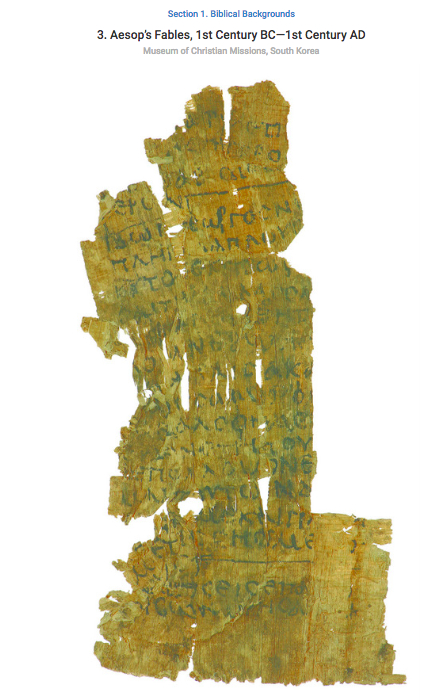
Aesop’s Fables? (unconfirmed identification by Scott Carroll). First appearance: 2016. Possibly associated with the collection of Andrew Stimer. Last seen in Scott Carroll’s exhibit in Belarus. More info here.

Aristotle, unknown work on reason? (unverified identification by Scott Carroll, Green Collection). First reference: 2011. This Green Collection papyrus was displayed in the first Verbum Domini exhibit (catalog entry pictured above). It was to be featured in the Brill series and was assigned to a date in the 3rd century BCE. [[Update 3 January 2020: I believe a photograph of this papyrus was posted online in 2014.]] Like so many other Green Collection pieces, this one is sometimes said to have been extracted from a mummy mask. More info here.
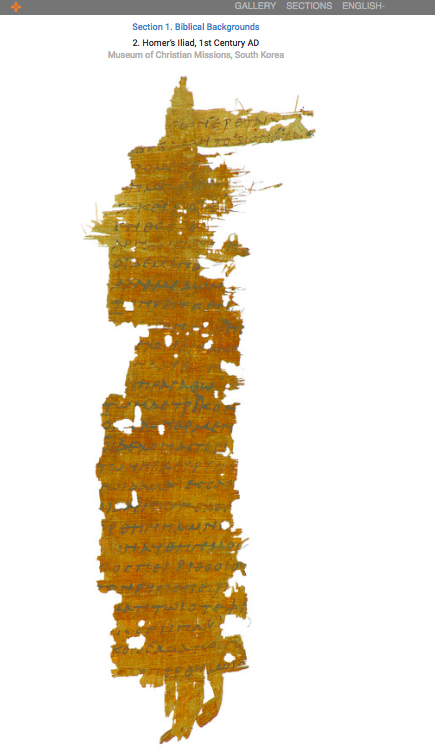
Homer, Iliad. First appearance: 2016. Possibly associated with the collection of Andrew Stimer. Last seen in Scott Carroll’s exhibit in Belarus. More info here.

Homer, Iliad, Book 1. First appearance: 2014. Image displayed by Scott Carroll in 2016. More info here.
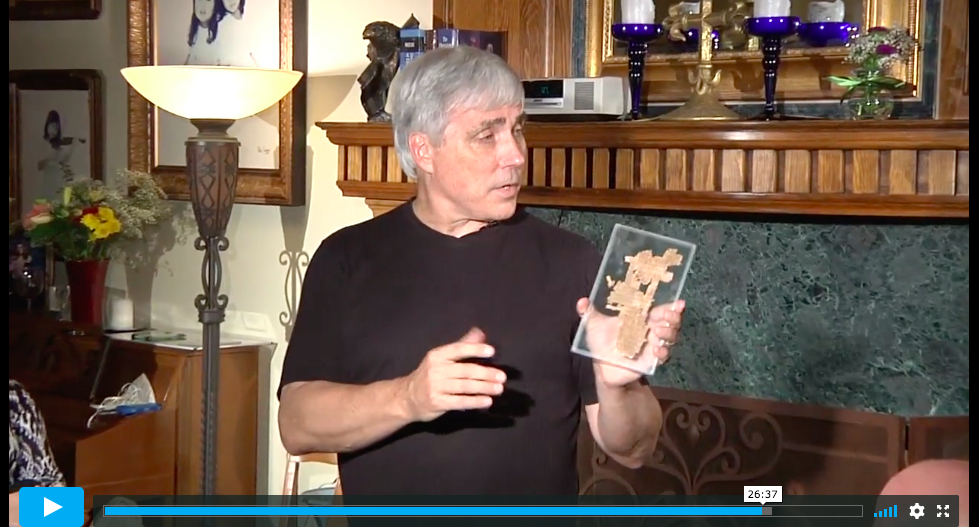
Homer, Iliad? (unconfirmed identification by Scott Carroll). First appearance: 2014. Papyrus displayed by Carroll in 2014. Said to be a leaf from a codex rather than a roll. More info here.
Homer, Iliad, fragment from Book 1 (GC.PAP.000451). First reference: 2017 (possibly 2012). This Green Collection papyrus is said to be under publication by Graeme Bird of Gordon College as of 2017. An image of Dr. Bird and a student with a papyrus can be seen in a 2014 article here with the following note: “In April 2012, Bird secured (through the Green Scholars Initiative) a loan of the rarest 1800-year-old papyrus of Homer’s Iliad in Greek for his students at Gordon.” But this may be one of several papyri of the Iliad from the Green Collection that were at one point at Gordon College.
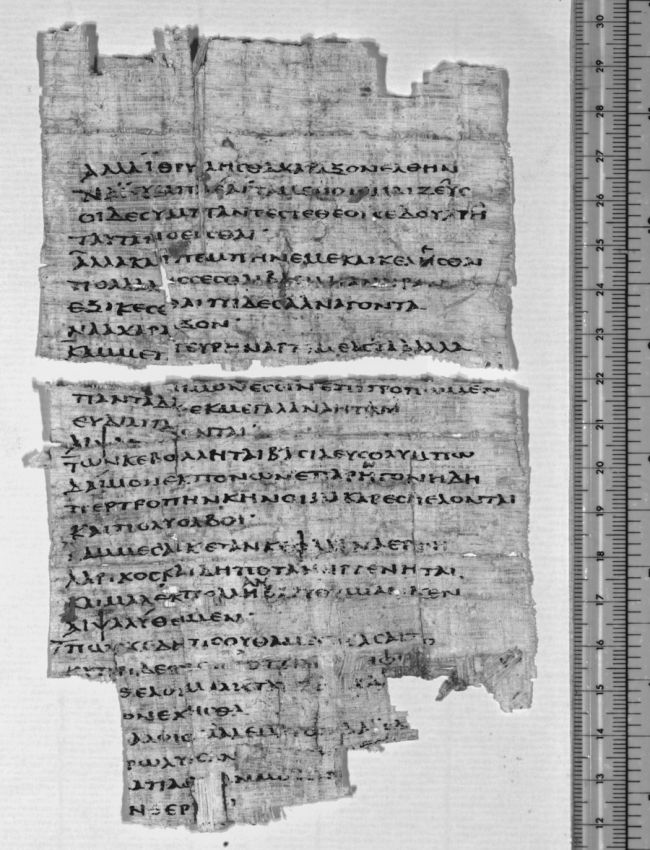
Sappho, Brothers poem. First appearance: 2012. A portion owned by “an anonymous collector” in London was published by Dirk Obbink in 2014 with provenance story full of holes. Another set of fragments are part of the Green Collection. Said by Obbink to have been radiocarbon dated, but no actual evidence of any radiocarbon test has been shown to date. Current location of the “London collector” portion of the papyrus is not known. More info here (last updated Aug. 2019).
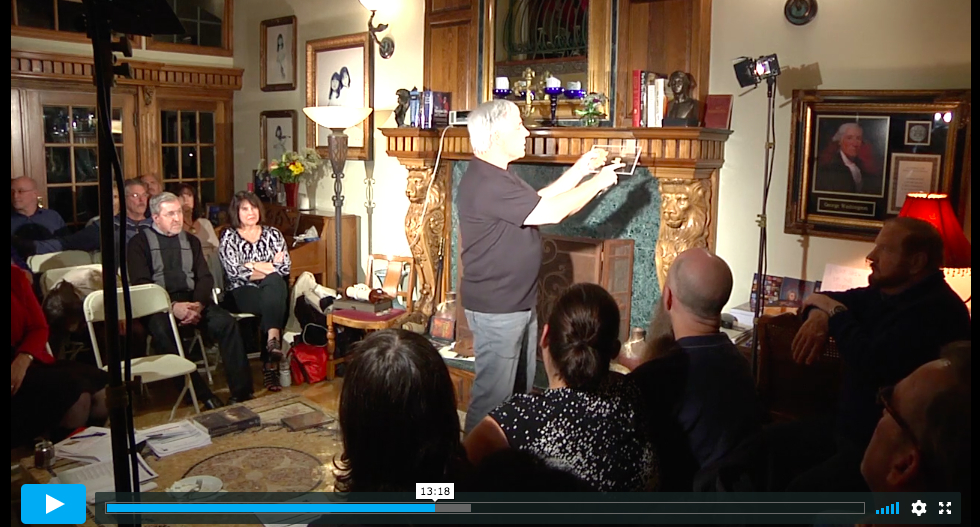
Aristophanes? (unconfirmed identification by Scott Carroll). First appearance: 2014. Papyrus displayed by Scott Carroll in 2016. More info here.

Life of Augustus? (Suetonius? unconfirmed identification by Scott Carroll). First appearance: 2016. Image displayed by Carroll in 2016 and identified only as “The Life of Caesar Augustus.” Possibly the parchment manuscript described at the beginning of this BMCR review.

Genesis 11 (image on the left; the image on the right is item number 2 on the EES’s list of stolen papyri, Genesis 17: P.Oxy. inv. 20 3B.30/F(5-7)b). First appearance: 2016. Images displayed by Scott Carroll in 2016. More info here. [[Update 21 October 2019: The fragment of Genesis 11 on the left is P.Oxy. inv. 11 1B.147/D(a) and remains in the EES collection. More info here.]]

Genesis 29:6-10. First appearance: Scott Carroll 2011. Part of the Green Collection (GC.PAP.000389). Assigned by Carroll to the second century CE. More info here.

Exodus 40. First appearance: 2016. Possibly associated with the collection of Andrew Stimer. Last seen in Scott Carroll’s exhibit in Belarus. More info here. [[Update 21 October 2019: This item is a part of the Stimer collection and was taken from the EES; it is P.Oxy. inv. 30 4B.37/F(1-3)c and will be returned to the EES. More info here.]]

Psalms 3 and 4. First appearance: 2013. Papyrus displayed by Scott Carroll in 2013. More info here. [[Update 21 October 2019: This item is a part of the Stimer collection and was taken from the EES; it is P.Oxy. inv. 100/103(b) and will be returned to the EES. More info here.]]
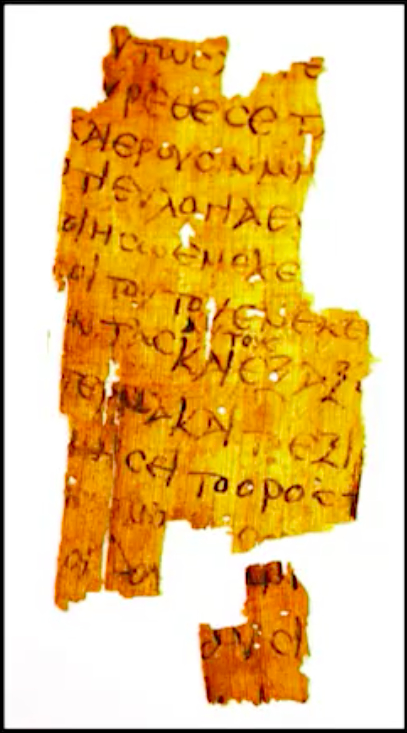
Isaiah 65. First appearance: 2016. Image displayed by Scott Carroll in 2016. More info here and here.
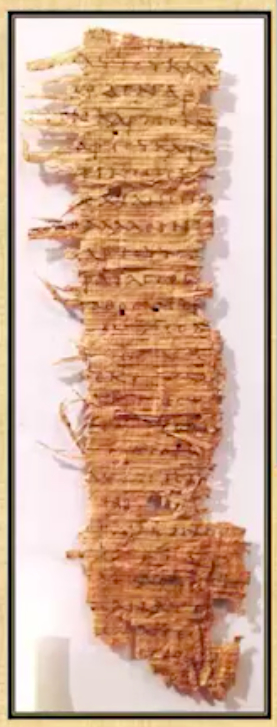
Matthew 12. First appearance 2016. Image displayed by Scott Carroll in 2016. Assigned by Carroll to the second century CE. More here. [[Update 21 October 2019: This fragment is P.Oxy. inv. 102/66(d) and remains in the EES collection. More info here.]]
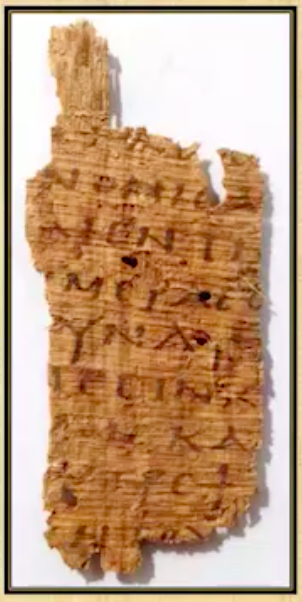
Luke 2:44-45. First appearance: 2016. Image displayed by Scott Carroll in 2016 (identified by Carroll as Luke 16). Assigned by Carroll to the second century CE. More info here. [[Update 21 October 2019: This fragment is P.Oxy. inv. 104/42(c) and remains in the EES collection. More info here.]]

Luke? (unconfirmed identification by Scott Carroll). First appearance: 2016. Image displayed by Scott Carroll in 2016. Assigned by Carroll to the second century CE. More info here. [[Update 21 October 2019: This fragment (Luke 12) is P.Oxy. inv. 106/113(c) and remains in the EES collection. More info here.]]

Luke 16. First appearance: 2016. Image displayed by Scott Carroll in 2016. More info here.

Romans 1 (GC.PAP.000390). First reference: 2014. This manuscript was on display at Verbum Domini II (2014) and was dated to 2nd-3rd century (catalog entry pictured above). More info here.
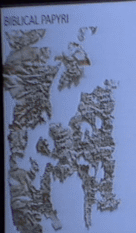
Romans 3-4? (on parchment, unconfirmed identification by Scott Carroll)? First appearance: 2016. Image displayed by Scott Carroll in 2016. No date assigned to the manuscript. More info here.
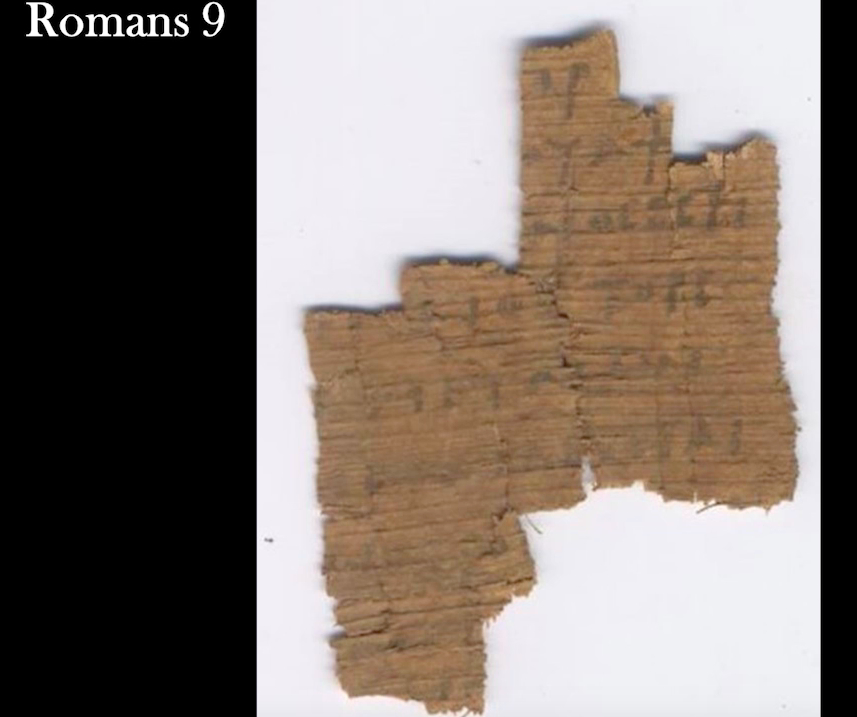
Romans 9? (unconfirmed identification by Scott Carroll; sometimes identified by Carroll as coming from the gospel of John). First appearance: 2016. Image displayed by Carroll in 2016. Assigned by Carroll to the second century CE. More info here.
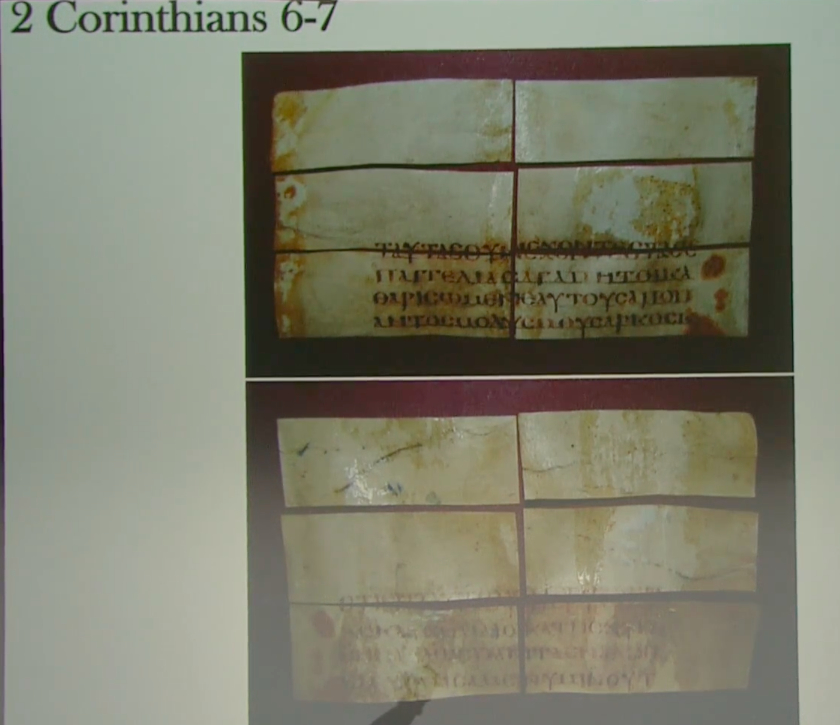
2 Corinthians 7 on parchment. First appearance: 2016. Image displayed by Scott Carroll in September 2016 (said to have been discovered “two weeks ago”). Assigned by Carroll to the fourth century. More info here.

Galatians 3-5. First appearance: 2016. Image displayed by Carroll in 2016. Presumably this is P135, owned by the Museum of the Bible (PAP.000531.1-2). Assigned to the fourth or fifth century by the INTF. More info here.

Hebrews 9. First appearance 2011. Image displayed by Scott Carroll in 2011. Probably the item formerly known as GC.PAP.000401 (now at Museum of the Bible?). P130. Assigned by the INTF to the third or fourth century. More info here.
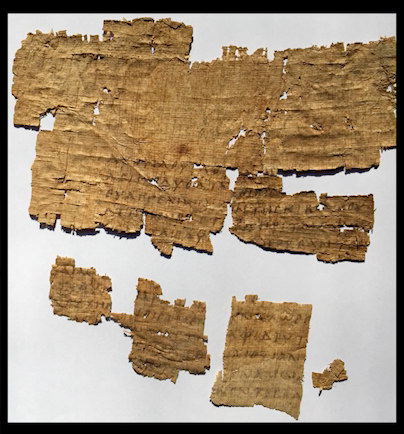
Patristic text? (unconfirmed identification by Scott Carroll). First appearance: 2016. Image displayed by Scott Carroll in 2016. Apparently fragments of a leaf from a codex. More info here.


Brent, do you happen to know how many, if any, of these dubious pieces in the Green Collection have been donated to MOTB vs. on loan from Green Collection at MOTB?
I’m not sure. Perhaps Mike Holmes could answer that.
What strikes me as strange is how Carroll was so open about these pieces that were obtained illegally. Is it possible that he believed Obbink had authority to sell the pieces, such as, on behalf of the EES? Thinking that the EES was getting paid and not Obbink?
Brent,
Thanks for posting this. Should the “first appearance” of the Aristophanes text be dated to 2014? Also, should the papyrus fragment of Exodus (40:26-29, 33-34)–which was also displayed in Belarus–be listed here?
It’s unfortunate that we do not have images of many of the texts that Carroll displays at his 2013 University of the Nations presentation. He passes around physical fragments of what he claims to be Menander, Euripides, Exodus 24, two fragments of Luke (including Luke 16), and Timothy. These may be in private collections now, never to be seen again.
Thanks, David. I do have images of a couple of those. I’ll get them posted in the coming days.
Also, recall Matthew 6 that Jerry Pattengale pulls out of his coat pocket during one of the OKC Passages Lecture Series in 2011. This fragment was also displayed at Verbum Domini in 2012. There’s a decent picture of it in Carroll’s 2016 Strategic Perspective presentation (Session 7, min. 34:48).
Thanks, David. This piece was on an earlier draft of the list, but Mike Holmes let me know that it was actually one of the stolen pieces on the EES list: 7. Sayings of Jesus: P.Oxy. inv. 16 2B.48/C(a). [PAP.000377] I don’t know why it is no longer identified as Matthew 6.
Brent,
That’s odd since Holmes’s information conflicts with the Verbum Domini exhibition guide and corresponding pictures from the display of these fragments at Verbum Domini. Perhaps Holmes can say more? I’m curious, was the exhibition guide and display at Verbum Domini mislabeled? This is certainly possible; I found one mislabeled papyrus facsimile when MOTB first opened. If these pieces were mislabeled, then what was text 0007, which was originally labeled as an apocryphal gospel? Also, what is the current known status of the Matthew 6 text?
The Annual Audit report is now available by the EES Chartered Accountants dated 10-3-19:
https://www.ees.ac.uk/Handlers/Download.ashx?IDMF=1678f0fe-82e3-4268-885c-3285e1c80e3b
Professor/Former Professor? Obbink seems to have acquired the naming status of Lord Voldemort (he who shall not be named). Regarding The Case of the Missing Papyri from the Memoirs of M. Holmes, the lack of direct mention in the Report, to use the Brits language, is a bit underwhelming. In my more familiar vernacular it is a Shanda. Lashon Horah. A Chillul Hashem. If one was not already familiar with the situation and an Auditor, one would not be aware of the situation from the Audit Report.
Indirect references in the Audit Report are as follows:
Library:
“In March 2019, a thorough survey of the EES Oxyrhynchus cartonnage collection (housed in
Oxford) was conducted by conservator Susi Pancaldo and volunteers Ellen Jones and Helen Neale.
This survey identified some urgent conservation needs within the collection which will be
investigated further as a priority.
…
PRINCIPAL RISKS AND UNCERTAINTIES
…
Safeguarding is considered a growing area of risk for the Society and a new policy will be
developed over 2019-20.”
If I was a contributor/potential contributor or British taxpayer I would want some details considering EES’ only significant asset is its inventory, the evidence indicates some of it has been stolen and sold for millions of dollars and EES is not sure of the extent of the theft.
MOTB is also a non-profit so maybe some of these details will be reported in their next Annual Report. Just kidding, but it does remind me that in order to raise funds for his legal defense (when he has run out of inventory) Obbink would like to know if anyone is interested in buying a Seaside Castle in Nazareth.
Wow.
I thought he had already sold the castle. I commented a few days ago that if EES had acted sooner they could have been proud owners of a castle, but alas….
“In March 2019, a thorough survey of the EES Oxyrhynchus cartonnage collection (housed in Oxford)”…
Does this imply that the missing papyri were from cartonnage, thus confirming some of the statements by various MOTB scholars re. mummy cartonnage as a provenance (that some of us have suspected was something of a laundering scheme)?
Sappho?
I have heard from a YouTube video when Dan Wallace was debating Bart Ehrman there was a reference somewhere along the line to a Hebrews 11 homily from the second century. Does anyone have any information about this piece? If you do could you please email me Chuckm137@gmail.com
I wonder if Dan Wallace made that reference during his first debate with Bart. I have the dvd, but it’s been too long since I’ve seen it to remember. It’s a shame that the first debate has to be purchased in order to watch it. I think enough time has went by that they should release it on YouTube.
What I remember is an interview with Hugh Hewitt after the debate and he mentioned this Hebrew 11 homily
Try looking here (scroll down to the Hebrews papyri): https://brentnongbri.com/2019/01/24/still-more-greek-and-coptic-papyri-from-scott-carroll/
Brent,
I just found something interesting and I don’t think it has been discussed before.
The MOTB list of papyri returned to the EES includes: Quotation of Hebrews: P.Oxy. inv. 105/188(c). [PAP.000378] This appears to be the same papyrus fragment discussed here:
Sylvie Raquel, Trinity International University “Discovering an Unknown Papyrus”
“A small number of students were involved in the deciphering of a recently discovered document. This Egyptian manuscript, dated of the second century, contains an adaptation from the letter to the Hebrews. Be the first ones to enjoy the unveiling of this papyrus and explore with us the implication of this discovery for the history of the transmission of the New Testament. We will also discuss the pedagogical aspects of this research.”
Click to access 2012MidwestSBL_AOS_ASOR_ProgramAbstracts.pdf
Compare also the comments by an unnamed former student of Bill Warren on this blog:
https://evangelicaltextualcriticism.blogspot.com/2012/01/new-fragment-of-romans-9-and-10.html
Yes it says Hebrews 11 non literary — maybe that is the Homily?? It seems wrapped in a rubber band!
Thank you for this link – I have been trying to chase this Hebrews 11 Homily for years now. It is very hard to find out what it says.
Way back before any of this became known Brice Jones used to blog about pieces he would find up for sale on eBay that had no known provenance or questionable provenance. I know we’ll never find out, but I’d like to know if the Greens were buying them without any thought to their origins. I’m not remotely suggesting Obbink was trickling them out on eBay way back when, but it would be nice to know where they wound up.
Obbink wasn’t the eBay seller – but those eBay Green papyri like Galatians were later given the same Christie’s provenance as the Sappho papyri, suggesting the same cartel was involved.
Pingback: A Statement from Dirk Obbink | Variant Readings
Brent, thanks so much for your work on this. I’d be very interested to know if there are any *unattributed* fragments that might be added to this list. That is, do all of the post-2010 appearances stem from canonical texts?
No, it seems that at least a couple of the items would be what modern scholars call “apocryphal” or “non-canonical”; see items 7 and 11-13 on the list of stolen EES papyri: https://brentnongbri.com/2019/10/14/breaking-ees-stolen-manuscripts-update/
Mike Holmes informed me that item 7 (“Sayings of Jesus”) could preserve portions of Matthew 6 or Luke 12, so we shouldn’t assume that it’s apocryphal. Several verses in Matthew 6 and Luke 12 closely parallel one another. So it could preserve verses from either of these passages or be “a bit of both, such as we find in Justin Martyr, 1 Apol., 15.14-15.”
Interesting: many thanks!
Pingback: More News on Stolen Papyri from the Egypt Exploration Society | Variant Readings
Another Green Collection papyrus was published by Dirk Obbink in 2011 in A Different God?: Dionysos and Ancient Polytheism edited by Renate Schlesier, pp. 291-294 with a photograph at pl. LIV fig. 4. See https://books.google.com/books?id=JZR_DU-GzoIC&pg=PA291 . More recent references to the papyrus (e.g. by Stefan Schorn in Studien zur hellenistischen Biographie und Historiographie (2018) 33 n. 154) seem to depend entirely on that edition rather than on sight of the original. Perhaps this is the “Unknown text on the Dionysiatic Mystery Rites” included in Scott Carroll’s “summary of discoveries 2011–present”.
Incidentally, the URL for that summary of discoveries is https://web.archive.org/web/20150516091020/http://ancientassetinvestments.com/wp-content/uploads/2013/12/drcarrolldiscoveries.pdf (in case this hasn’t been cited here before).
Incredible–I can’t believe I missed this. THANK YOU for making it more widely known.
Pingback: A New(-ish) Published Papyrus from the Green Collection! | Variant Readings
Pingback: The Coptic Material from Oxyrhynchus | Variant Readings
Pingback: An Image of the Green Collection "Aristotle" Papyrus? | Variant Readings
Pingback: Recently Emerged Coptic Manuscripts of Dubious Origins: A Working List | Variant Readings
Dear Dr. Nongbri, Thanks for all you are doing with this. I am doing research on Genesis 5/11 and the fragment above of Genesis 11 got my attention. Is there a better image of this fragment available somewhere, and do you know if it has been transcribed? All the best, Henry B. Smith Jr. Associates for Biblical Research Akron PA
I’m pretty sure that’s the best image online. There’s another slide with that piece here: https://brentnongbri.com/2019/01/24/still-more-greek-and-coptic-papyri-from-scott-carroll/
thank you!
Pingback: The Odyssey of an Iliad Papyrus | Roberta Mazza